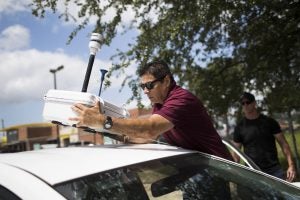Hyperlocal air monitoring is a powerful new tool for communities that want to take charge of their air and the health consequences of pollution. The United States Environmental Protection Agency (EPA) made $20 million available for a new community air monitoring grant program, with no cost-sharing needed. EPA is encouraging community-based organizations to apply for the grants.
The impact of community-driven monitoring is impressive and growing. Interest in community monitoring is inspired, in part, by gaps in the current monitoring networks operated by federal and state governments:
- Pollution can be as much as eight times higher at one end of the block than the other. This variation has major health impacts: Oakland neighborhoods with higher percentages of residents of color experienced double the rate of childhood asthma from traffic-related air pollution (nitrogen dioxide) compared with predominantly white neighborhoods.
- Many of the monitors capture data only one out of every six days, and a recent study found that companies pollute more when the government isn’t watching.
- Satellite data shows that millions of people may be breathing air that doesn’t meet the legal minimum standard in the blind spots around federal regulatory monitors.

Communities are applying local data to a variety of exciting uses. They are securing new regulatory monitors, achieving funding for pollution reductions, reducing truck traffic into waste transfer stations, challenging permits for warehouses, demanding more transparency for truck-attracting facilities, inspiring student engagement, educating residents about health impacts of air quality, and much more.
The funding
The EPA funds are intended “to support community and local efforts to monitor their own air quality and to promote air quality monitoring partnerships between communities and tribal, state, and local governments.” Grant sizes range from $25,000 to $500,000. Eligible entities are states (including the District of Columbia); local governments; U.S. territories and possessions; Indian tribes; public and private hospitals and laboratories; and other public or private nonprofit organizations. $2 million is set aside for tribal governments, and $2 million is set aside for eligible community-based organizations. Projects must be completed within three years.
Further details can be found here. The application deadline is March 25, 2022.
If you believe more funding can help you strengthen hyperlocal monitoring in your community, below are some resources that might help. This is not an exhaustive discussion of application requirements. Applicants should review the information package.
A few resources:
- Making the Invisible Visible, EDF’s guide to hyperlocal mapping. It outlines how to understand the opportunities and challenges, nuts and bolts of a monitoring network, how to handle and analyze data, and using data to inspire solutions
- Global Clean Air’s resources, including research studies
- Future Fleets, EDF’s guide to mobile mapping on fleet vehicles such as municipal cars, and Houston’s experience with mobile mapping on vehicles going about their regular business
- One Breath Partnership, including stories from Houston communities doing their own monitoring
